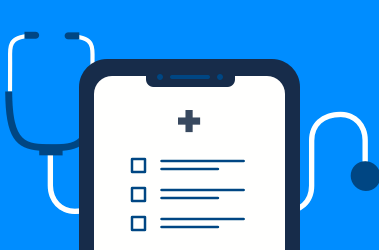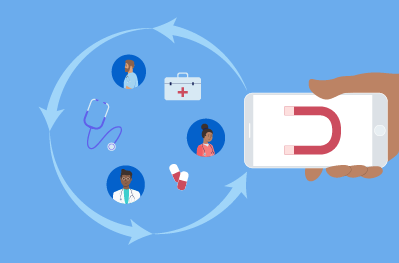Skedulo’s intelligent scheduling platform helps you manage your mobile workforce with worker- and travel-friendly schedules.
Your patients receive the care they need, and your caregivers get the autonomy and flexibility they need to focus on what they do best.
“Care more, drive less”
Home healthcare providers have tough jobs — and there’s a shortage of these valuable professionals; the U.S. Bureau of Labor Statistics projects1 nearly 600,000 openings for home health and personal care aides each year between 2020 and 2030. Many of those positions are directly related to attrition in an industry that sees a roughly 60% annual turnover rate.
At the same time, home healthcare agencies today aren’t just competing against one another to enlist clinicians, they’re competing with other health systems, big chain retailers like Amazon and Walmart, and buzzy technology startups. You have to get creative to attract talent to your team.
In this environment, it’s important to minimize headaches and make your mobile providers’ jobs easier, since happier workers lead to happier clients and better health outcomes. But how?
In this eBook, we illustrate a better way to match the unique needs of each client with available resources and skills, a way to minimize missed appointments and double-bookings, and a smarter way to plan and coordinate assignments, so mobile workers can spend more time providing care and less time driving.
How scheduling volatility affects caregiver turnover
In a 2021 study2, researchers probed the role of scheduling volatility in turnover of nurses in home healthcare.
Analyzing HR records and visit log data from a large multi-state home healthcare organization, researchers found that more than 27% of full-time registered nurse (RN) caregivers quit their employer each year, while 4.25% were involuntarily separated. Among full-time licensed professional nurses (LPNs), those figures were just over 20% and 5%, respectively. Part-time RNs and LPNs quit at slightly higher rates and had slightly lower rates of involuntary separation.

Among the notable findings:
- Scheduling volatility was higher for part-time nurses than for full-time nurses, yet higher volatility was much more associated with turnover of full-time nurses.
- Over 360 days of employment, a nurse’s probability of leaving the home health company was higher over the first 180 days than in the subsequent 180 days.
- The risks of quitting varied widely, from 40% less likely than the average nurse to quit for RNs in the 5th percentile of schedule volatility to 51% more likely to quit for RNs in the 95th percentile — meaning those nurses with more predictable scheduling were far less likely to leave.
With changing reimbursement requirements and high rates of caregiver burnout, home healthcare is already a tough environment in which to operate successfully. Giving your caregivers the stability and predictability they need gives you a greater change of bringing your entire organization into harmony.
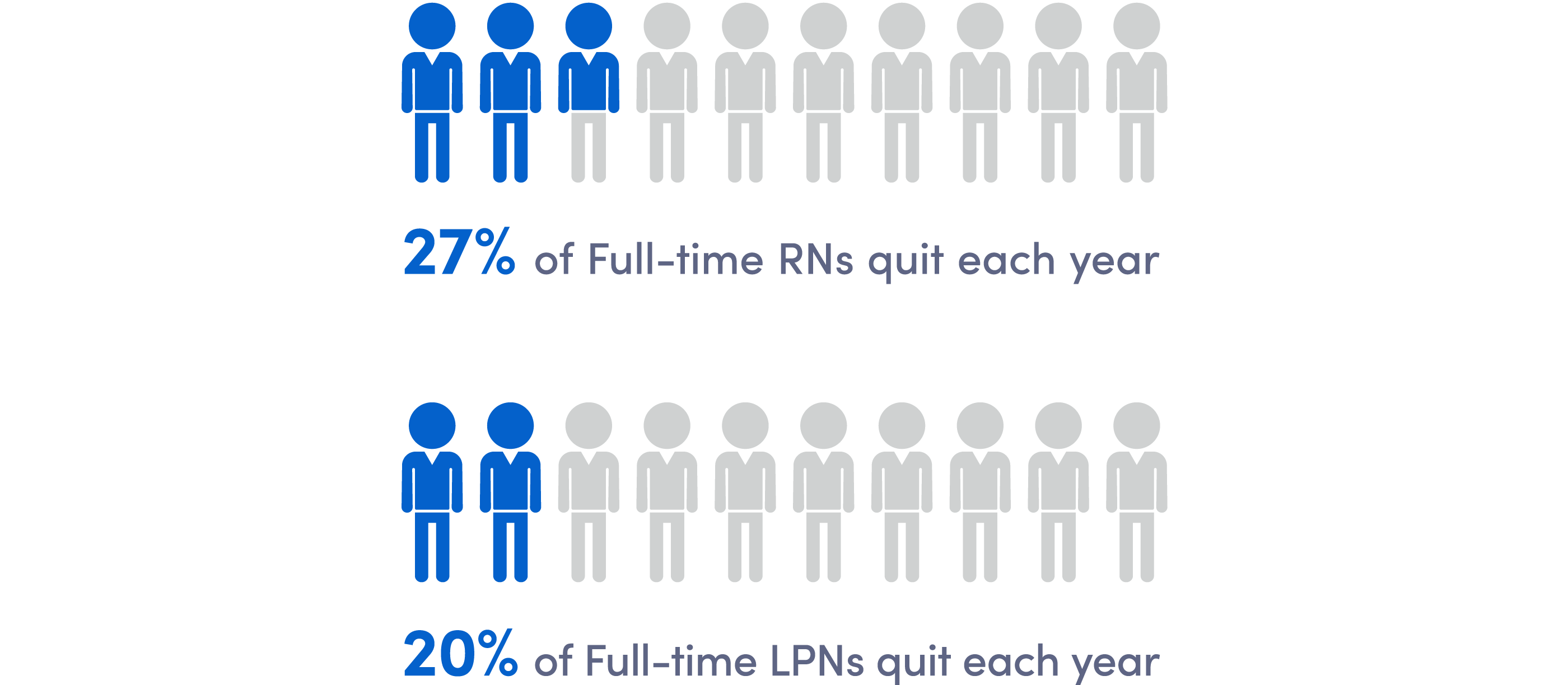
The challenges of home healthcare
The industry is changing
The old ways of running a home healthcare business — including using a fee-for-service model as a foundation for billing — will no longer cut it. New funding initiatives like CMS’ Patient-Driven Groupings Model and regulations like Medicaid’s Electronic Visit Verification are emerging, bringing new time limits, visit thresholds and outcome expectations to the reimbursement equation. To increase revenue, you need to streamline processes and focus on improving outcomes. Increasing productivity and being smarter about allocating resources, such as knowing when to deploy a home care aide versus a more costly LPN, will be key. So will the ability to cater to patients’ personal needs, such as sending a bilingual clinician to a patient whose primary language is Spanish.
Meanwhile, there’s an abundance of research linking digital maturity and worker autonomy with employee satisfaction. Put simply, giving your mobile caregivers the tools they need to do their jobs efficiently and effectively makes them more likely to stick around.
Technology in home healthcare
Technology can play a big role in helping home health agencies, yet research commissioned by Skedulo3 suggests that home healthcare lags behind:
- Nearly half of healthcare organizations remain heavily reliant on cumbersome paper-based processes.
- 63% of executives admit that deskless workers lack access to critical software in the field.
- 72% of executives believe worker productivity is hindered by their existing technology.
- Only 13% of healthcare organizations report that their mobile caregivers have a high degree of control over their schedule, while 58% said they had moderate control and 30% said they had a low degree of control.
- More than one in four respondents expect to be 100% digital in the next 1-2 years, up from just 6% today.
How intelligent scheduling can get your team in tune
With Skedulo’s intelligent home care scheduling software as a service and mobile app, managing complex schedules for your mobile caregivers is a breeze. Skedulo offers an easy and secure way to manage appointments, juggle late changes, simplify assignments and travel logistics, and empower your caregivers. Our platform lets you more easily match the skills and personalities of your mobile workers with the clinical needs and preferences of your clients.
Skedulo offers many benefits for home healthcare agencies:
- Cuts travel time by assigning work based on caregiver proximity and clustering nearby appointments, with schedules tailored to the caregiver
- Avoids missed appointments, via automated reminders, and overlapping or double bookings
- Prioritizes jobs and appointments based on urgency
- Gives clinicians the power of choice with work offers
- Collects patient data remotely in a HIPAA-compliant platform
- Provides an Android and iOS mobile app for mobile workers
- Offers API integration to third-party systems
- Increases efficiency, reduce costs
- Visualizes your capacity to increase patient base through more intakes and referrals
- Increases patient satisfaction
Case Study
Solace Pediatric Home Healthcare
Before Skedulo, Solace used email to make important scheduling and assignment decisions. With more than 3,500 appointments each week, this manual process simply couldn’t keep up with demand, nor was it making things easier for their clinicians.
Today, Solace uses Skedulo to ensure they’re always assigning the best clinician available to a family for the duration of the service. Skedulo also allowed them a way to better capture patient information and data remotely, with the ability to sync in real-time on our mobile platform and integrate with Solace’s EHR system.
For the clinicians, Skedulo helps reduce the time spent driving between appointments. It also gives them more stable, predictable hours and pay, with repeat visits with families that build connection and support positive outcomes.
“We’ve had an overwhelmingly positive response about ease of use. We regularly hear from clinicians how our centralized, mobile scheduling system is a game changer in the market. It’s a huge selling point from a recruiting and marketing standpoint.”
Why make scheduling easy for home caregivers?
Home health workers are among the 80% of the global workforce that is deskless or mobile. These companies recognize the value of worker autonomy, with potential to help in areas like employee satisfaction and retention, performance and great customer service. But worker autonomy remains lacking in home healthcare.
Fewer than one in seven home healthcare providers have a high degree of autonomy today, our survey found. Three in 10 said their mobile caregivers had a low degree of control over accepting job offers in real time or to influence their work schedules. At the same time, a huge majority believe that providing caregivers with more autonomy will pay off in the form of stronger employee retention, customer satisfaction, better patient outcomes and improved market share.
Yet home healthcare lags behind in adopting the kinds of technology that can help streamline operations. Currently, coordinating caregivers’ schedules is fragmented between multiple different platforms like email or text messaging — or no platform at all. In fact, only 6% of home health agencies reported being 100% digital for its mobile workforce. One-third said it was 50-50 between digital and paper-based processes.
When asked about their priorities for their organizations over the next one to two years, 24% of respondents said improving customer service and satisfaction, while 22% said limiting attrition and strengthening employee retention.
Losing employees throws your entire organization off-key. It’s time to get connected.
How home healthcare organizations get thrown off key
Many home healthcare agencies use a mix of full- and part-time employees, plus contractors, per-diem and on-call workers, and even volunteers to deliver care in patients’ homes. It can be tough Many have a difficult time connecting with this disparate group of caregivers. Using whiteboards for scheduling remains commonplace, making it difficult to communicate appointment changes when workers are en route or at a client’s home, with care coordinators plugging in assignments on a whiteboard, which is of little use in communicating when things change and your caregivers are already en route to an appointment — or you don’t know exactly where they are in the field.
Organizations know that to keep their workers happy and be competitive differentiate themselves in the market, they have to accommodate a broad array of working arrangements for mobile caregivers. And that means offering flexible travel schedules tailored to their needs options that are beneficial to all workers, with ways to communicate with them in real time to convey late-breaking scheduling changes and other important information, and knowledge of their whereabouts so you can assign them to nearby appointments and better maximize their time.
In reality, most home healthcare workers see high variability in their scheduling. Many don’t get scheduled for enough appointments, or they have experience inconsistency in the volume of appointments from week to week, drastically affecting their pay. And many spend too much time traveling between appointments instead of seeing patients.
Home healthcare workers providers can’t afford unpredictability, and so many simply quit to take positions in other fields industries that offer steadier hours and pay. Some agencies opt to guarantee minimum hours and pay as a hedge against for cancellations or missed appointments, by patients. But to highlighting the need for a way to analyze appointment trends and cancellations by patients to make scheduling more consistent for caregivers. That, you need assurance that scheduling runs smoothly and efficiently, with the ability to meet the demands of your patients while accommodating the flexibility your caregivers need.
Home healthcare scheduling checklist
To stay ahead of the competition, you need to be able to deliver care more efficiently than ever before. But not all scheduling tools can handle the complex scheduling needs of home healthcare. Here are the key attributes a modern home healthcare scheduling solution should have:
1. Is 100% secure, HIPAA-compliant
Security and compliance are a must in healthcare. Software connectivity should have sound security protocols, using secure APIs to transfer details about insurance, payroll, medical care, the patient’s medical history, care notes and other personal identifying information covered by HIPAA.
2. Assigns the right healthcare provider to the patient
Your customers are putting the ultimate trust in your organization by inviting your mobile caregivers into their homes. The ideal scheduling solution should go well beyond just factoring in availability by weighing a host of other key considerations:
- Patient relationships: patients may prefer to work with someone who has previously treated them
- Patient preferences: female patients may prefer a female provider, and vice versa
- Business rules: certain types of appointments may require specialists or a different number of providers than usual
- Employee certification and skill sets: some services may require additional certification or deep skills that make some employees uniquely qualified (or unqualified) to perform the work
- Employee location and travel time: unless other constraints apply, our solution finds the best route to the closest location to maximize visits and minimize time spent driving
3. Care providers can easily view schedule changes in the field
Caregivers need an easy way to send and receive updates throughout the day, while connecting all the data to your system of record. With mobile devices and technology, there’s no reason to rely on paper schedules, phone calls or even email to keep team members up to date and coordinated.
4. Gives providers easy access to patient information
No patient wants to repeat information from the last appointment (or even worse, schedule a follow-up appointment because the provider wasn’t prepared). Your scheduling solutions should offer seamless access to important appointment information, including patient history and necessary equipment.
5. Collects relevant appointment and job details and syncs automatically
Overwhelming documentation requirements are the top source of frustration for home healthcare workers. Many have to spend more time charting information than caring for patients, and many have to manually enter data into a database when they are done. Look for a solution that keeps your mobile caregivers connected to the latest information about their patients, including up-to-date care notes and special instructions. With this capability, caregivers can record signatures, complete forms or snap and upload pictures on the go. That way, caregivers can get back to providing care, and your back office administrators can get to work processing data from the field.
6. Handles time-sensitive schedules and recurring visits
Look for a scheduling system that makes it easy to plan around the time-sensitive needs of medical care, easily accommodating recurring visits, unusual patterns for patient check-ins and related scenarios.
7. Manages full-time, part-time, temporary and contract workers
Your tools should allow you to keep track of your staff as well as contractors, plus the various disciplines on your team — nursing, therapists, home health aides, counseling, care coordinators. It’s especially valuable for teams managing timesheets, payroll and billing when information about services is synced directly to the organization’s system of record.
8. Allows data access in a way that reflects the needs of your workforce
A solid scheduling solution should allow you to customize access and permissions to information along different status, roles and access types, so only the right people have access to protected patient data.
9. Keeps a record of provider credentials and skill sets
Healthcare organizations need a comprehensive, up-to-date view of their providers’ skills, qualifications and certifications, so your organization can provide the best care possible and maintain compliance with rules and regulations.
10. Gives the back office real-time insight into the field
While mobile caregivers are working at patients’ homes, back office administrators are usually in the dark about where caregivers are and where they’re headed next, leaving them unable to make scheduling changes or provide updates to patients who are waiting. The right scheduling tool lets schedulers and other office employees see when providers check into appointments, what services were provided and when the appointment wrapped up. That’s helpful as a health and safety benefit, or when you need to:
- Update a patient who is waiting
- Create performance reports
- Forecast demand more accurately
- Better understand your marketing needs or determine market trends
- Determine your staffing capacity and ability to bring on new patients
- Define your growth strategy
11. Works without an internet connection
Home health caregivers work in many different settings, including remote areas without a cellular signal or home internet connectivity. This highlights the importance of being able to work in offline mode, so your providers can access important information even when they can’t connect to the web.
How it works
At Skedulo, we engage patients and caregivers in the dynamic delivery of care anytime, anywhere. With our platform, you can:
- Manage day-to-day scheduling of your mobile workers
- Engage caregivers with what’s happening at the home office through easy ways to communicate throughout the day
- Analyze data and insights through our dashboard
Configure & Extend data from CRM, EMR/EHR or other systems and share it with third-party systems, such as payroll
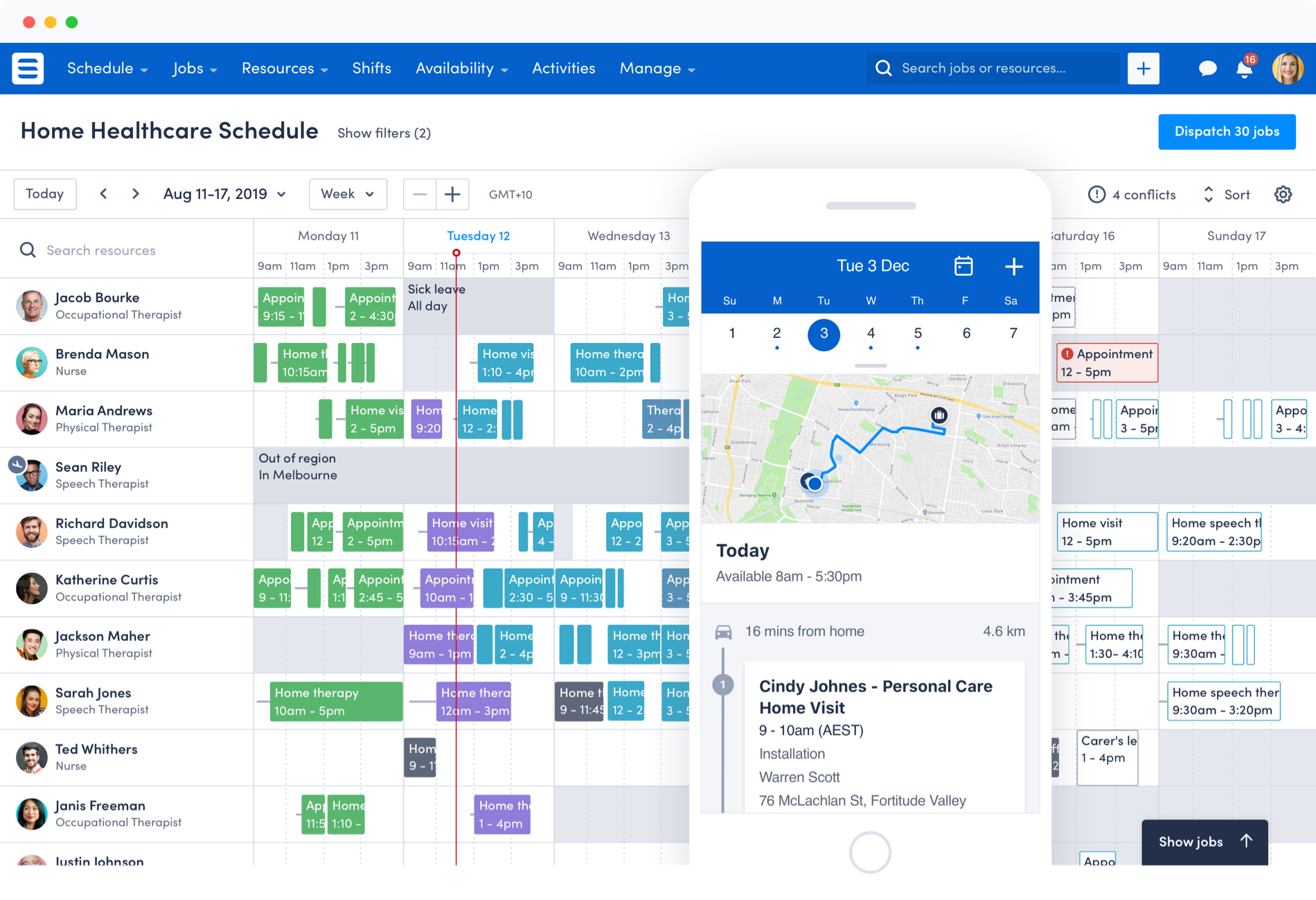
Web application
This is where care coordinators and schedulers spend most of their time. View rosters of mobile workers, their availability and the types of appointments that need scheduling for the day. Filter by location, the patient’s needs, the skills and certifications of your caregiver. Then crunch the data to bring up the top available workers, based on their proximity to the appointment and properly matched skills or credentials. Finally, automatically notify your caregivers about their appointments for the day, along with the best route to those appointments, in just a few clicks.
Mobile app
Clinicians use our app to get notifications about newly scheduled and upcoming appointments, receive messages from schedulers, view appointment details, set their availability, accept or deny appointments and submit time sheets. They can also find important notes about patient care, parking or other instructions for arrival. Additionally, they can upload photos or leave notes about their visit for use during future visits.
Did you know? Skedulo is built to integrate with your systems — CRM, EMR, Salesforce and more — while being 100% secure and HIPAA-compliant.
The Skedulo Impact
Skedulo gives your team access to smarter, real-time scheduling. The end result? Happier caregivers, patients and schedulers, and a healthier bottom line.
Patients
Honor your patients’ care preferences and match them with the skills and certifications they need.
Mobile caregivers
Make their time count with route optimization, real-time communication and access to key tools and information from the field.
Schedulers/care coordinators
More easily manage your mobile caregivers in real-time and better match available skills to the needs of patients.
Back office/business owners
Make data-driven, strategic decisions and improve performance, patient outcomes and employee retention.
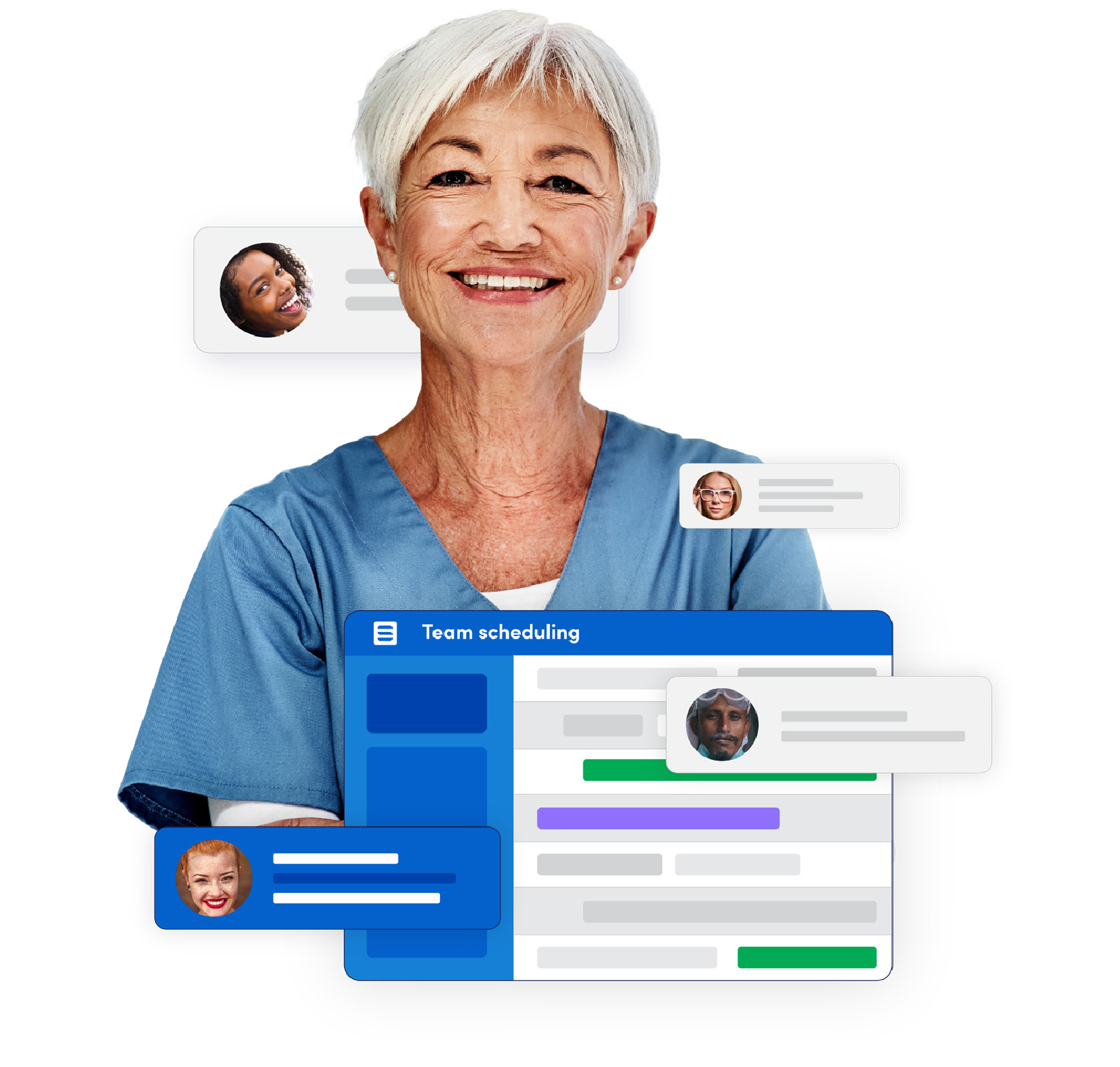

Easy scheduling.
Happy people.
Learn how Skedulo can help you make scheduling easy.
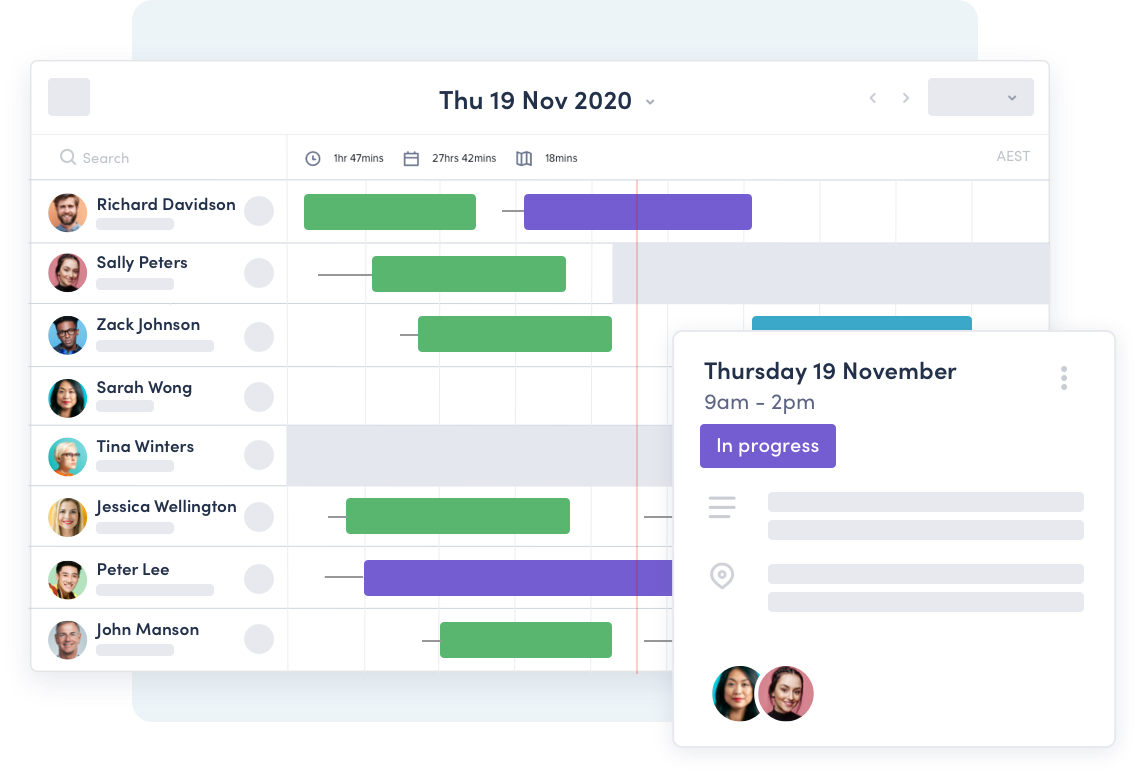
References
- U.S. Bureau of Labor Statistics, Home Health and Personal Care Aides https://www.bls.gov/ooh/healthcare/home-health-aides-and-personal-care-aides.htm
- “The Role of Schedule Volatility in Home Health Nursing”; Bergman, Song, David, Spetz, and Candon, Medical Care Research and Review, July 2021 https://journals.sagepub.com/doi/10.1177/10775587211034310
- “The State of Deskless Work: Q4 2021 Research Report,” https://info.skedulo.com/rs/960-CDH-700/images/Skedulo_Q42021-State-of-Deskless-Work-Research-Report.pdf

